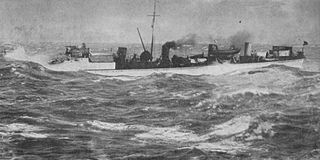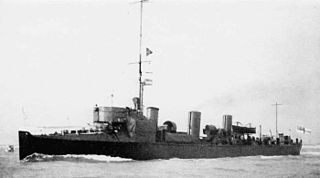
HMS Sparrowhawk was a B-class torpedo boat destroyer of the Royal Navy. She was completed by Laird, Son & Company, Birkenhead, and was launched on 8 October 1895. She served on the China Station and was wrecked in the mouth of the Yangtze River in 1904. She was one of four Quail-class destroyers.

HMS Virago was a B-class torpedo boat destroyer of the British Royal Navy. She was completed by Laird Brothers, Birkenhead, in 1897. One of four Quail-class destroyers she served during the Great War and was sold off after hostilities ended.
HMS Orwell was a B-class torpedo boat destroyer of the British Royal Navy. She was built by Laird, Son & Company, and served from 1900 until 1920.
HMS Success was a B-class torpedo boat destroyer of the Royal Navy. She was launched on 21 March 1901. On 27 December 1914 she was wrecked off Fife Ness during heavy gales.

The three Ardent-class torpedo boat destroyers were ordered by the British Admiralty on 12 October 1893 and served with the Royal Navy. Built by Thornycroft for a contract price of £110,520 for all three vessels, they displaced 301 tons fully laden, and were 201 feet 8 inches (61.47 m) long overall.
Two Hardy-class destroyers served with the Royal Navy. HMS Hardy and HMS Haughty were both built by Doxford, ordered on 3 November 1893. They were fitted with 8 Yarrow boilers. They displaced 260 tons, were 196 feet long and were armed with one twelve pounder quick-firing gun mounted forward and five 6-pounder guns, mounted on the broadside and aft, and two torpedo tubes on a revolving mount. They carried 53 officers and men, and served in home waters before being sold off in 1911 and 1912 respectively.
HMS Hasty was a Charger-class destroyer which served with the Royal Navy. She was launched by Yarrow Shipbuilders in 1894, served in home waters and was sold off in 1912.
HMS Hardy was a Hardy-class destroyer which served with the Royal Navy. She was built by William Doxford & Sons in 1895, launched on 16 December 1895, and sold off on 11 July 1911.
HMS Porcupine was a Janus-class destroyer of the Royal Navy. She was launched by Palmers Shipbuilding and Iron Company in 1895, served in home waters and was in service during the First World War.
The Salmon class were two destroyers built by Earle's to an Admiralty specification for service with the Royal Navy.

HMS Lynx was a Ferret-class destroyer which served with the Royal Navy. She was launched in 1894 and sold in 1912.

The Banshee class was a class of three torpedo boat destroyers that served with the Royal Navy into the early part of the Twentieth century.

HMS Banshee was one of three Banshee-class destroyers which served with the Royal Navy.
HMS Fervent was a Fervent-class destroyer which served with the Royal Navy. Fervent was launched on 28 March 1895 at Paisley.
Two Swordfish-class destroyers served with the Royal Navy. Swordfish and Spitfire were both built by Armstrong Whitworth at Elswick, Tyne and Wear launching in 1895. Fitted with Yarrow boilers, they could make 27 knots and were armed with one twelve pounder and two torpedo tubes.

Three Conflict-class destroyers served with the Royal Navy. All were built by the White Shipyard.

HMS Handy was a Handy-class destroyer which served with the Royal Navy. Built by Fairfield Shipbuilding and Engineering Company in 1895 she spent most of her time on the China Station, and was sold in Hong Kong during the Great War.

The Sturgeon-class destroyers served with the Royal Navy from 1894; three were built by the Vickers yard and differed from other similar ships in having their mast stepped before the first funnel. They had Blechynden boilers which gave them 4,000 hp (3,000 kW) and 27 knots. They were armed with one twelve pounder and two torpedo tubes. They carried a complement of 53 officers and men.
HMS Peterel was one of two Spiteful-class destroyers to serve with the Royal Navy. She was built by Palmers, was 215 feet long and the 6,200 H.P. produced by her Reed boilers gave her a top speed of 30 knots. She was armed, as was standard, with a twelve pounder and two torpedo tubes. She served in home waters throughout the Great War and was sold off in 1919.

HMS Velox was a turbine-powered torpedo boat destroyer of the British Royal Navy built on speculation in 1901-04 by engineering firm Parsons Marine, with the hull subcontracted to Hawthorn Leslie and Company at Hebburn on the River Tyne. Velox served in the First World War, being sunk by striking a mine in 1915.










